Building Information Modelling Diffusion Research in Developing Countries: A User Meta-Model Approach
Abstract
1. Introduction
2. BIM Adoption in Developing Countries
2.1. Capital Investment
2.2. Actor Dependent Factors
2.3. Peculiar BIM Barriers to Adoption
3. Methodology
| Country | Study | Approach | BIM Maturity | Barriers to Adoption |
|---|---|---|---|---|
| Nigeria | Diffusion of Innovations: The Status of Building Information Modelling Uptake in Nigeria [52] | Questionnaire survey | 59.5% BIM awareness level; 22.8% BIM adoption level 17.7% are aware nor using BIM | -lack of experts -lack of collaboration by other stakeholders -lack of Standardised tools and protocol -Cost |
| Assessment of BIM Implementation among MEP Firms in Nigeria [53] | Fieldwork survey using structured questionnaires. | MEP firms have a relatively high level of BIM awareness | -lack of technical expertise on BIM tools utilisation -lack of awareness -high investment cost in training staff -process change -software/hardware upgrade | |
| Ghana | Acceptance of Building Information Modelling: a survey of professionals in the construction industry in Ghana [54] | Questionnaire | The study observed a positive intention to adopt BIM by professionals using the technology acceptance model (TAM). The study also posits that a change in professionals’ perception will ensure a change in attitude. It can be inferred that the barriers to adoption are summountible through a change in their perception and attitudes. | |
| Guideline for building the capacity of Contractors for adoption and implementation of Building Information Modeling (BIM) in Ghana [55] | Quantitative approach. Non-probability sampling technique. | Low BIM maturity level. | -high set up cost -software and personnel training -legal issues in relation to the ownership of the model -lack of knowledge of the enormous benefits of BIM. | |
| South Africa | Understanding Building Information Modelling in the South Africa construction industry [19] | Questionnaires | Low BIM maturity; BIM is scarcely used hence professionals have minimal exposure to it. | -lack of skills -education -knowledge of BIM |
| A study on the BIM adoption readiness and possible mandatory initiatives for successful implementation in South Africa [40] | Questionnaire survey | Low BIM maturity level | -BIM experience and education -reluctance to change current work practices -low levels of commitment from public sector clients. | |
| India | State of BIM Adoption and Outlook in India [56] | Online survey and Semi-structured interviews | 22% uses BIM; 27% considering BIM usage. 43% aware of BIM but are not sure about implementing 8% respondents are not aware of BIM | -Mind-set issues -Difficulties in adapting to frequent changes in design -No mandate from government for BIM implementation -interoperability -High cost -lack of practical knowledge |
4. Data Analysis
4.1. Research Publication Network and Co-Authorship
4.2. Analysis of Sources
5. Research Trends
5.1. BIM for Sustainable Construction
5.2. BIM Adoption
5.3. BIM and Other Technologies
5.4. BIM for the Safe and Effective Construction Process
5.5. BIM for Facility Management
5.6. BIM Tools Interaction and Integration
6. Current Research Directions
7. Future Trends
8. Conclusions
Author Contributions
Funding
Conflicts of Interest
Appendix A
Search Querry
| Search String | Output |
|---|---|
| TITLE-ABS-KEY (“BIM” OR “Building information modelling”) AND (LIMIT-TO (AFFILCOUNTRY, “Taiwan”) OR LIMIT-TO (AFFILCOUNTRY, “Malaysia”) OR LIMIT-TO (AFFILCOUNTRY, “India”) OR LIMIT-TO (AFFILCOUNTRY, “Brazil”) OR LIMIT-TO (AFFILCOUNTRY, “Turkey”) OR LIMIT-TO (AFFILCOUNTRY, “Egypt”) OR LIMIT-TO (AFFILCOUNTRY, “Chile”) OR LIMIT-TO (AFFILCOUNTRY, “Nigeria”) OR LIMIT-TO (AFFILCOUNTRY, “Thailand”) OR LIMIT-TO (AFFILCOUNTRY, “Pakistan”) OR LIMIT-TO (AFFILCOUNTRY, “South Africa”) OR LIMIT-TO (AFFILCOUNTRY, “Mexico”) OR LIMIT-TO (AFFILCOUNTRY, “Ghana”) OR LIMIT-TO (AFFILCOUNTRY, “Morocco”) OR LIMIT-TO (AFFILCOUNTRY, “Tunisia”) OR LIMIT-TO (AFFILCOUNTRY, “Jordan”) OR LIMIT-TO (AFFILCOUNTRY, “Cameroon”) OR LIMIT-TO (AFFILCOUNTRY, “Central African Republic”) OR LIMIT-TO (AFFILCOUNTRY, “Cote d’Ivoire”) OR LIMIT-TO (AFFILCOUNTRY, “Ethiopia”) OR LIMIT-TO (AFFILCOUNTRY, “Kenya”) OR LIMIT-TO (AFFILCOUNTRY, “Libyan Arab Jamahiriya”) OR LIMIT-TO (AFFILCOUNTRY, “Malawi”) OR LIMIT-TO (AFFILCOUNTRY, “Mozambique”) OR LIMIT-TO (AFFILCOUNTRY, “Sudan”) OR LIMIT-TO (AFFILCOUNTRY, “Trinidad and Tobago”) OR LIMIT-TO (AFFILCOUNTRY, “Zambia”)) AND (LIMIT-TO (SUBJAREA, “ENGI”)) AND (LIMIT-TO (PUBYEAR, 2019) OR LIMIT-TO (PUBYEAR, 2018) OR LIMIT-TO (PUBYEAR, 2017) OR LIMIT-TO (PUBYEAR, 2016) OR LIMIT-TO (PUBYEAR, 2015) OR LIMIT-TO (PUBYEAR, 2014) OR LIMIT-TO (PUBYEAR, 2013) OR LIMIT-TO (PUBYEAR, 2012) OR LIMIT-TO (PUBYEAR, 2011) OR LIMIT-TO (PUBYEAR, 2010) OR LIMIT-TO (PUBYEAR, 2009) OR LIMIT-TO (PUBYEAR, 2008) OR LIMIT-TO (PUBYEAR, 2007) OR LIMIT-TO (PUBYEAR, 2006) OR LIMIT-TO (PUBYEAR, 2003) O LIMIT-TO (PUBYEAR, 2002) OR LIMIT-TO (PUBYEAR, 2001) OR LIMIT-TO (PUBYEAR, 1995) OR LIMIT-TO (PUBYEAR, 1989) |
References
- Azhar, S.; Hein, M.; Sketo, B. Building Information Modeling (BIM): Benefits, Risks and Challenges. In Proceedings of the 44th ASC Annual Conference, Auburn, AL, USA, 2–5 April 2008; Available online: http://ifcworkshop.es/downloads_files/Estudio_BIM_Alabama.pdf (accessed on 1 May 2021).
- Gilligan, B.; Kunz, J. VDC Use in 2007: Significant Value, Dramatic Growth, and Apparent Business Opportunity; CIFE: Stanford, CA, USA, 2007. [Google Scholar]
- Bensalah, M.; Elouadi, A.; Mharzi, H. Overview: The opportunity of BIM in railway. Smart Sustain. Built Environ. 2019, 8, 103–116. [Google Scholar] [CrossRef]
- Eastman, C.M. BIM Handbook: A Guide to Building Information Modeling for Owners, Managers, Designers, Engineers and Contractors; Wiley: Hoboken, NJ, USA, 2011; Available online: https://books.google.co.za/books?hl=en&lr=&id=aCi7Ozwkoj0C&oi=fnd&pg=PP7&ots=ZbDeOUz7Iq&sig=yvlZ_9-KVeVMEAmjXEog94FzI7Q&redir_esc=y#v=onepage&q&f=false (accessed on 4 June 2019).
- Barlish, K.; Sullivan, K. How to measure the benefits of BIM—A case study approach. Autom. Constr. 2012, 24, 149–159. [Google Scholar] [CrossRef]
- Bryde, D.; Broquetas, M.; Volm, J.M. The project benefits of Building Information Modelling (BIM). Int. J. Proj. Manag. 2013, 31, 971–980. [Google Scholar] [CrossRef]
- Stanley, R.; Thurnell, D.P. The benefits of, and barriers to, implementation of 5D BIM for quantity surveying in New Zealand. Constr. Econ. Build. 2014, 14, 105–117. [Google Scholar] [CrossRef]
- Lu, W.; Fung, A.; Peng, Y.; Liang, C.; Rowlinson, S. Cost-benefit analysis of Building Information Modeling implementation in building projects through demystification of time-effort distribution curves. Build. Environ. 2014, 82, 317–327. [Google Scholar] [CrossRef]
- Al Ahbabi, M.; Alshawi, M. BIM for client organisations: A continuous improvement approach. Constr. Innov. 2015, 15, 402–408. [Google Scholar] [CrossRef]
- Nii, N.; Armah, O. Assessing the Benefits and Barriers of the Use of Building Information Modelling (Bim) In the Ghanaian Building Construction Industry. Master’s Thesis, Kwame Nkrumah University of Science and Technology, Kumasi, Ghana, 2015. [Google Scholar]
- Mostafa, S.; Kim, K.P.; Tam, V.W.Y.; Rahnamayiezekavat, P. Exploring the status, benefits, barriers and opportunities of using BIM for advancing prefabrication practice. Int. J. Constr. Manag. 2020, 20, 146–156. [Google Scholar] [CrossRef]
- Edirisinghe, R.; London, K. Comparative analysis of international and national level BIM standardization efforts and BIM adoption. In Proceedings of the 32nd CIB W78 Conference 2015, Eindhoven, The Netherlands, 27–29 October 2015; pp. 149–158. [Google Scholar]
- Jung, W.; Lee, G. The status of BIM adoption on six continents. Int. J. Civil Environ. Eng. 2015, 9, 512–516. Available online: https://www.semanticscholar.org/paper/The-Status-of-BIM-Adoption-on-Six-Continents-Jung-Lee/ea0d7a32ebe25d64509e4224e6be9371c6aa1369#paper-header (accessed on 5 June 2019).
- Chan, D.W.; Olawumi, T.O.; Ho, A.M. Perceived benefits of and barriers to Building Information Modelling (BIM) implementation in construction: The case of Hong Kong. J. Build. Eng. 2019, 25, 100764. [Google Scholar] [CrossRef]
- Elagiry, M.; Marino, V.; Lasarte, N.; Elguezabal, P.; Messervey, T. BIM4Ren: Barriers to BIM implementation in renovation processes in the Italian market. Buildings 2019, 20, 24. [Google Scholar] [CrossRef]
- Oraee, M.; Hosseini, M.R.; Edwards, D.J.; Li, H.; Papadonikolaki, E.; Cao, D. Collaboration barriers in BIM-based construction networks: A conceptual model. Int. J. Proj. Manag. 2019, 37, 839–854. [Google Scholar] [CrossRef]
- Adekunle, S.A.; Aigbavboa, C.O.; Ejohwomu, O.A. BIM implementation: Articulating the hurdles in developing countries. In Proceedings of the 8th International Conference on Innovative Production and Construction (IPC), Hong Kong, China, 7–8 December 2020. [Google Scholar]
- Kekana, T.; Aigbavboa, C.; Thwala, W. Building Information Modelling (BIM): Barriers in adoption and implementation strategies in the South Africa construction industry. In Proceedings of the International Conference on Emerging Trends in Computer and Image Processing, Pattaya, Thailand, 15–16 December 2014. [Google Scholar]
- Kekana, G.; Aigbavboa, C.; Thwala, W. Understanding building information modelling in the South Africa construction industry. In Proceedings of the OTMC2015 Conference, Primošten, Croatia, 2–6 September 2015. [Google Scholar]
- Ugochukwu, S.C.; Akabogu, S.C.; Chuks, K.O. Status and perceptions of the application of building information modeling for improved building projects delivery in Nigeria. Am. J. Eng. Res. 2015, 4, 176–182. Available online: www.ajer.org (accessed on 8 June 2019).
- Hamid, A.B.A.; Taib, M.Z.M.; Razak, A.H.N.A.; Embi, M.R. Building Information Modelling: Challenges and Barriers in Implement of BIM for Interior Design Industry in Malaysia. IOP Conf. Ser. Earth Environ. Sci. 2018, 140, 012002. [Google Scholar] [CrossRef]
- Mansur, H.-A.; Tahar, K. A review on building information modelling in Nigeria and its potentials. Int. J. Civil Environ. Eng. 2018, 12, 11. Available online: http://waset.org/publications/10009816/a-review-on-building-information-modelling-in-nigeria-and-its-potentials (accessed on 8 June 2019).
- Saka, A.B.; Chan, D.W.M. A scientometric review and metasynthesis of building information modelling (BIM) research in Africa. Buildings 2019, 9, 85. [Google Scholar] [CrossRef]
- Ullah, K.; Lill, I.; Witt, E. An Overview of BIM Adoption in the Construction Industry: Benefits and Barriers. In Proceedings of the 10th Nordic Conference on Construction Economics and Organization, Tallinn, Estonia, 7-8 May 2019; Emerald Publishing Limited: Bingley, UK, 2019; Volume 2, pp. 297–303. [Google Scholar]
- Ofori, G. Challenges of Construction Industries in Developing Countries: Lessons from Various Countries, Construction Management and Economics; National University of Singapore: Singapore, 2007; Volume 25, pp. 1–6. Available online: https://www.irbnet.de/daten/iconda/CIB8937.pdf (accessed on 6 June 2019).
- Wang, G.; Wu, P.; Wu, X.; Zhang, H.; Guo, Q.; Cai, Y. Mapping global research on sustainability of megaproject management: A scientometric review. J. Clean. Prod. 2020, 259, 120831. [Google Scholar] [CrossRef]
- Aghimien, D.O.; Aigbavboa, C.O.; Oke, A.E.; Thwala, W.D. Mapping out research focus for robotics and automation research in construction-related studies. J. Eng. Des. Technol. 2019, 18, 1063–1079. [Google Scholar] [CrossRef]
- Zhong, B.; Wu, H.; Li, H.; Sepasgozar, S.; Luo, H.; He, L. A scientometric analysis and critical review of construction related ontology. In Automation in Construction; Elsevier: Amsterdam, The Netherlands, 2019; Volume 101, pp. 17–31. [Google Scholar] [CrossRef]
- Li, C.Z.; Zhao, Y.; Xiao, B.; Yu, B.; Tam, V.W.; Chen, Z.; Ya, Y. Research trend of the application of information technologies in construction and demolition waste management. J. Clean. Prod. 2020, 263, 121458. [Google Scholar] [CrossRef]
- Wu, C.-M.; Liu, H.-L.; Huang, L.-M.; Lin, J.-F.; Hsu, M.-W. Integrating BIM and IoT technology in environmental planning and protection of urban utility tunnel construction. In Proceedings of the 2018 IEEE International Conference on Advanced Manufacturing (ICAM), Yunlin, Taiwan, 16–18 November 2018; pp. 198–201. [Google Scholar]
- He, Q.; Wang, G.; Luo, L.; Shi, Q.; Xie, J.; Meng, X. Mapping the managerial areas of Building Information Modeling (BIM) using scientometric analysis. Int. J. Proj. Manag. 2017, 35, 670–685. [Google Scholar] [CrossRef]
- Gerbert, P.; Castagnino, S.; Rothballer, C.; Renz, A.; Filitz, R. The Transformative Power of Building Information Modeling. 2016. Available online: https://www.bcg.com/publications/2016/engineered-products-infrastructure-digital-transformative-power-building-information-modeling.aspx (accessed on 5 June 2019).
- Georgiadou, M.C. An overview of benefits and challenges of building information modelling (BIM) adoption in UK residential projects. Constr. Innov. 2019, 19, 298–320. [Google Scholar] [CrossRef]
- Bouguerra, K.; Lim, Y.-W.; Nita, K.; Ali, B. An investigation of the challenges and the best practices of BIM implementation in the Algerian AEC industry. Int. J. Adv. Sci. Technol. 2020, 29, 287–300. [Google Scholar]
- Rogers, J.; Chong, H.-Y.; Preece, C. Adoption of building information modelling technology (BIM). Eng. Constr. Arch. Manag. 2015, 22, 424–445. [Google Scholar] [CrossRef]
- Usman, N.; Said, I. Key Factors that affects adoption of technology in the Nigerian construction firms: A theoretical framework. Int. J. Account. Bus. Manag. 2014, 2, 26–38. [Google Scholar]
- NBS. National BIM Report 2019—The Definitive Industry Update; NBS: London, UK, 2019; pp. 1–28. [Google Scholar]
- NBS. National BIM Report 2012 What will BIM Mean for Design Fees? Available online: https://www.thenbs.com/knowledge/nbs-national-bim-report-2012 (accessed on 1 May 2021).
- Sahil, A.Q. Adoption of Building Information Modeling in Developing Countries: A Phenomenological Perspective. 2016. Available online: https://mountainscholar.org/bitstream/handle/10217/173492/Sahil_colostate_0053N_13498.pdf?sequence=1 (accessed on 8 June 2019).
- Chimhundu, S. A study on the BIM Adoption Readiness and Possible Mandatory Initiatives for Successful Implementation in South Africa. 2015. Available online: http://wiredspace.wits.ac.za/handle/10539/22184 (accessed on 1 May 2021).
- Harris, V. BIM It’s Your Move; BIM: Cape Town, South Africa, 2019. [Google Scholar]
- Giddens, A. The Constitution of Society, Outline of the Theory of Structuration; University of California Press: Berkeley, CA, USA, 1984. [Google Scholar]
- Pedregosa, F.; Varoquaux, G.; Gramfort, A.; Michel, V.; Thirion, B.; Grisel, O.; Vanderplas, J. Building information modelling adoption: An analysis of the barriers to implementation. J. Eng. Arch. 2014, 2, 77–101. [Google Scholar] [CrossRef]
- Saka, A.B.; Chan, D.W.M.; Siu, F.M.F. Adoption of building information modelling in small and medium-sized adoption of building information modelling in small and medium-sized enterprises in developing countries: A system dynamics approach. In Proceedings of the CIB World Building Congress 2019, Hong Kong, China, 17–21 June 2019. [Google Scholar]
- Guz, A.N.; Rushchitsky, J.J. Scopus: A system for the evaluation of scientific journals. Int. Appl. Mech. 2009, 45, 351–362. [Google Scholar] [CrossRef]
- Aksnes, D.W.; Sivertsen, G. A Criteria-based Assessment of the Coverage of Scopus and Web of Science. J. Data Inf. Sci. 2019, 4, 1–21. [Google Scholar] [CrossRef]
- Van Eck, N.J.; Waltman, L. VOS: A new method for visualizing similarities between objects. In Advances in Data Analysis; Studies in Classification Data Analysis and Knowledge Organization; Decker, R., Lenz, H.J., Eds.; Springer: Berli/Heidelberg, Germany, 2007; pp. 299–306. [Google Scholar]
- Van Eck, N.J.; Waltman, L. Manual for VOSviewer Version 1.6.10. 2019. Available online: https://www.vosviewer.com/documentation/Manual_VOSviewer_1.6.10.pdf (accessed on 1 May 2021).
- Börner, K.; Chen, C.; Boyack, K.W. Visualizing knowledge domains. Annu. Rev. Inf. Sci. Technol. 2005, 37, 179–255. [Google Scholar] [CrossRef]
- Van Eck, N.J.; Waltman, L. Bibliometric Mapping of the Computational Intelligence Field Nees. Int. J. Uncertain. Fuzz. Knowl. Based Syst. 2007, 15, 625–645. [Google Scholar] [CrossRef]
- UN. Country Classification Data Sources, Country Classifications and Aggregation Methodology Data Sources. 2014. Available online: http://data.worldbank.org/about/country-classifications (accessed on 23 July 2020).
- Hamma-Adama, M.; Salman, H.; Kouider, T. Diffusion of Innovations: The Status of Building Information Modelling Uptake in Nigeria. J. Sci. Res. Rep. 2018, 17, 1–12. [Google Scholar] [CrossRef]
- Wang, C.; Adetola, S.H.; Abdul-Rahman, H. Assessment of BIM Implementation among MEP Firms in Nigeria. Int. J. Adv. Appl. Sci. 2015, 4, 73–81. [Google Scholar] [CrossRef][Green Version]
- Acquah, R.; Eyiah, A.K.; Oteng, D. Acceptance of Building Information Modelling: A Survey of Professionals in the Construction Industry in Ghana. J. Inf. Technol. Constr. (ITcon) 2018, 23, 75–91. Available online: http://www.itcon.org/2018/4 (accessed on 22 December 2019).
- Akwaah, G. Guideline for Building the Capacity of Contractors for Adoption and Implementation of Building Information Modeling (BIM) in Ghana. Master’s Thesis, Kwame Nkrumah University of Science and Technology, Kumasi, Ghana, 2015. [Google Scholar]
- Sawhney, A. State of BIM Adoption and Outlook in India. 2014. Available online: http://www.fig.net/resources/proceedings/fig_proceedings/fig2014/ppt/ss36/ss36_kavanagh_7434.pdf (accessed on 2 September 2019).
- Ogino, P. Digital Architecture: Digital Aspects of the Process of Design and the Architectural Space. 2006. Available online: https://www.researchgate.net/publication/292203265_Digital_architecture_Digital_aspects_of_the_process_of_design_and_the_architectural_space (accessed on 9 August 2020).
- Liu, Z.; Lu, Y.; Peh, L.C. A Review and Scientometric Analysis of Global Building Information Modeling (BIM) Research in the Architecture, Engineering and Construction (AEC) Industry. Buildings 2019, 9, 210. [Google Scholar] [CrossRef]
- Leite, F.; Akcamete, A.; Akinci, B.; Atasoy, G.; Kiziltas, S. Analysis of modeling effort and impact of different levels of detail in building information models. Autom. Constr. 2011, 20, 601–609. [Google Scholar] [CrossRef]
- Ilter, D.; Ergen, E. BIM for building refurbishment and maintenance: Current status and research directions. Struct. Surv. 2015, 33, 228–256. [Google Scholar]
- Göçer, Ö.; Hua, Y.; Göçer, K. Completing the missing link in building design process: Enhancing post-occupancy evaluation method for effective feedback for building performance. Build. Environ. 2015, 89, 14–27. [Google Scholar] [CrossRef]
- Wang, M.; Liu, P.; Zhang, R.; Li, Z.; Li, X. A Scientometric Analysis of Global Health Research. Int. J. Environ. Res. Public Health 2020, 17, 2963. [Google Scholar] [CrossRef] [PubMed]
- Lu, Y.; Wu, Z.; Chang, R.; Li, Y. Building Information Modeling (BIM) for green buildings: A critical review and future directions. Autom. Constr. 2017, 83, 134–148. [Google Scholar] [CrossRef]
- Chong, H.-Y.; Lee, C.-Y.; Wang, X. A mixed review of the adoption of Building Information Modelling (BIM) for sustainability. J. Clean. Prod. 2017, 142, 4114–4126. [Google Scholar] [CrossRef]
- Maltese, S.; Tagliabue, L.C.; Cecconi, F.R.; Pasini, D.; Manfren, M.; Ciribini, A.L.C. Sustainability Assessment through Green BIM for Environmental, Social and Economic Efficiency. Procedia Eng. 2017, 180, 520–530. [Google Scholar]
- Carvalho, J.P.; Bragança, L.; Mateus, R. Optimising building sustainability assessment using BIM. Autom. Constr. 2019, 102, 170–182. [Google Scholar]
- Ilhan, B.; Yaman, H. Green building assessment tool (GBAT) for integrated BIM-based design decisions. Autom. Constr. 2016, 70, 26–37. [Google Scholar] [CrossRef]
- Rogers, E.M. Diffusion of Innovations, 3rd ed.; Simon and Schuster: New York, NY, USA, 1962. [Google Scholar]
- Memon, A.H.; Rahman, I.A.; Memon, I.; Azman, N.I.A. BIM in Malaysian Construction Industry: Status, Advantages, Barriers and Strategies to Enhance the Implementation Level. Res. J. Appl. Sci. Eng. Technol. 2014, 8, 606–614. [Google Scholar] [CrossRef]
- Li, Y.; Li, W.; Tang, S.; Darwish, W.; Hu, Y.; Chen, W. Automatic Indoor As-Built Building Information Models Generation by Using Low-Cost RGB-D Sensors. Sensors 2020, 20, 293. [Google Scholar] [CrossRef]
- Olugboyega, O.; Windapo, A. Building Information Modeling—Enabled construction safety culture and maturity model: A grounded theory approach. Front. Built Environ. 2019, 5, 35. [Google Scholar] [CrossRef]
- Raol, P.H.; Deshmukh, S.; Pitroda, J.R. Integration of BIM with Lean Principles in Indian Construction Industry. Int. Res. J. Eng. Technol. 2020, 7, 7. Available online: www.irjet.net (accessed on 15 August 2020).
- Hamdi, O.; Leite, F. BIM and Lean interactions from the BIM capability maturity model perspective: A case study. In Proceedings of the 20th Annual Conference of the International Group for Lean Construction, San Diego, CA, USA, 18–20 July 2012; Available online: http://www.caee.utexas.edu/prof/leite/ (accessed on 23 December 2019).
- Nascimento, D.L.D.M.; Quelhas, O.L.G.; Meiriño, M.J.; Caiado, R.G.G.; Barbosa, S.D.J.; Ivson, P. Facility Management Using Digital Obeya Room by Integrating Bim-Lean Approaches—An Empirical Study. J. Civ. Eng. Manag. 2018, 24, 581–591. [Google Scholar] [CrossRef]
- Liang, T.-W.; Chang, P.-H.; Tsai, C.-F. Research on the Technical Integration of Heterogeneous Materials into Building Information Modeling. In Proceedings of the 2019 IEEE Eurasia Conference on IOT, Communication and Engineering (ECICE), Yunlin, Taiwan, 3–6 October 2019; pp. 313–315. [Google Scholar]
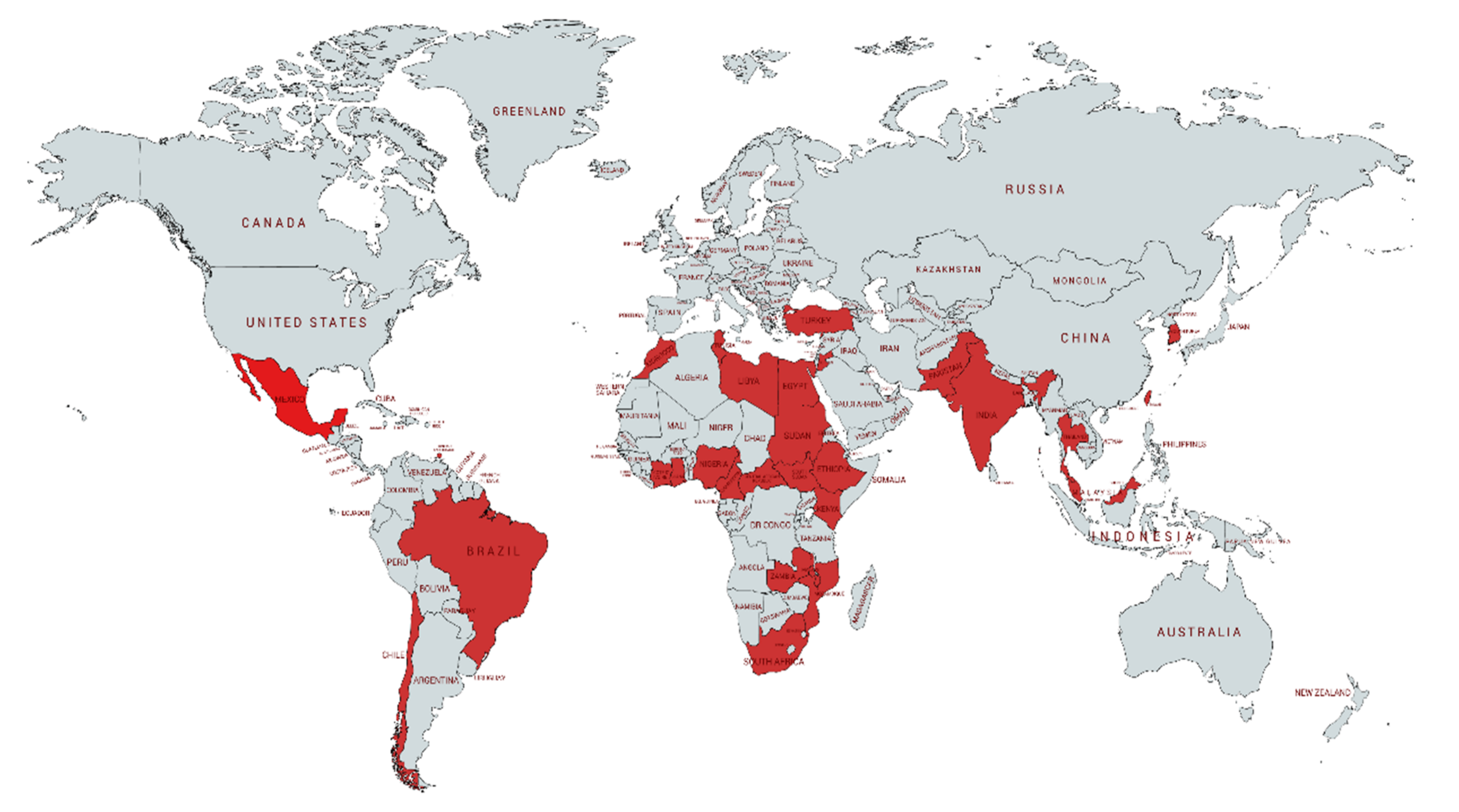
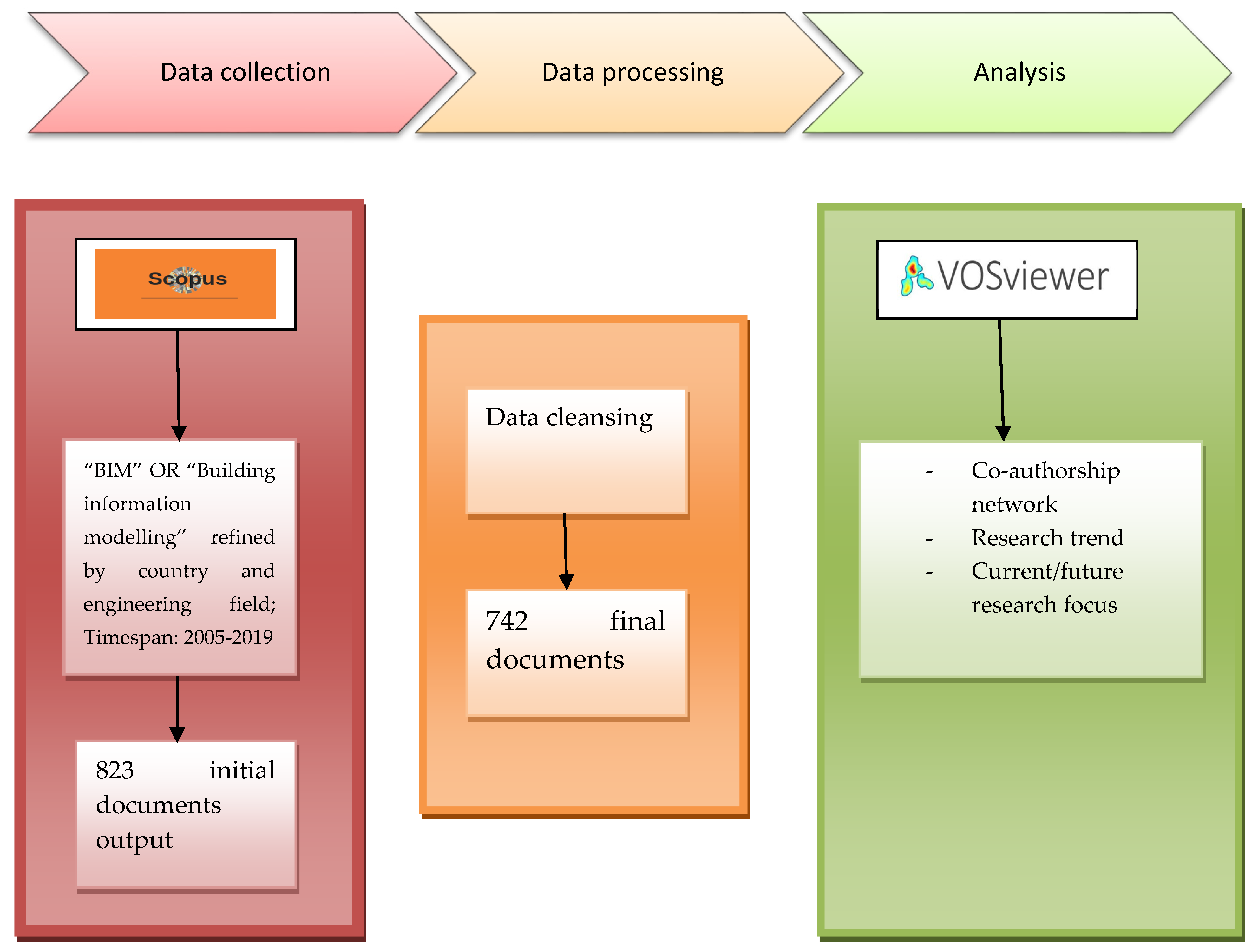
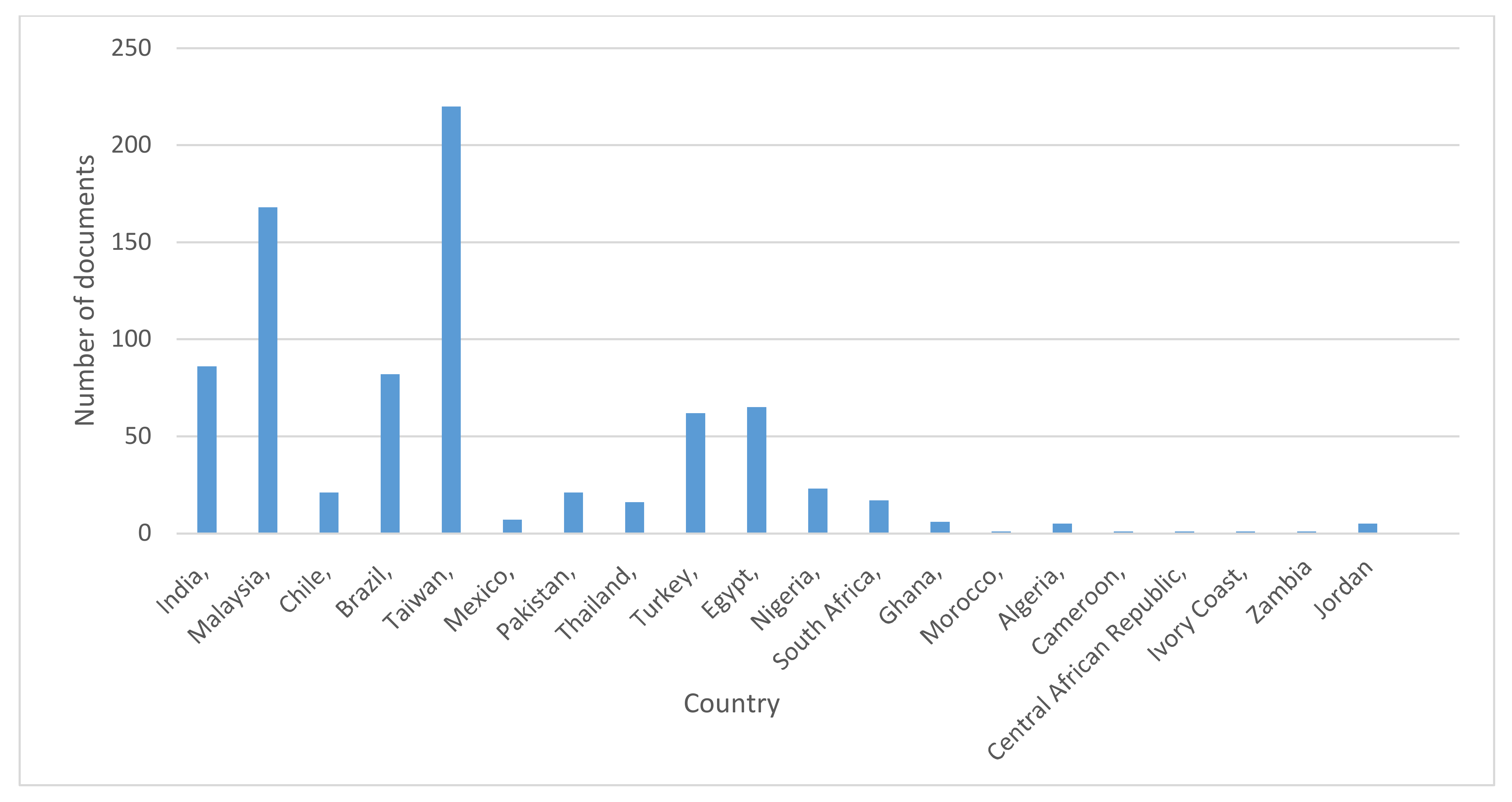
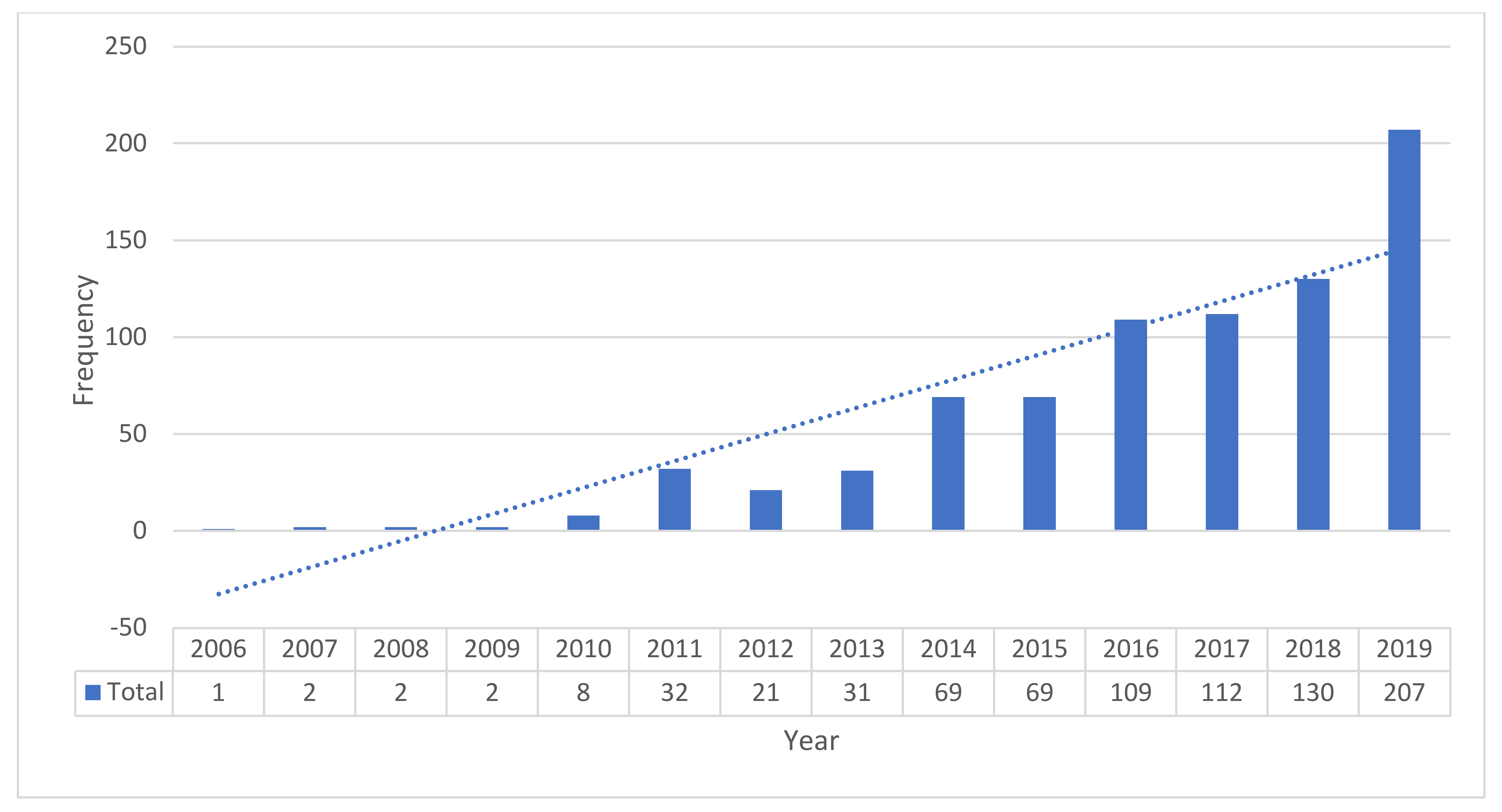
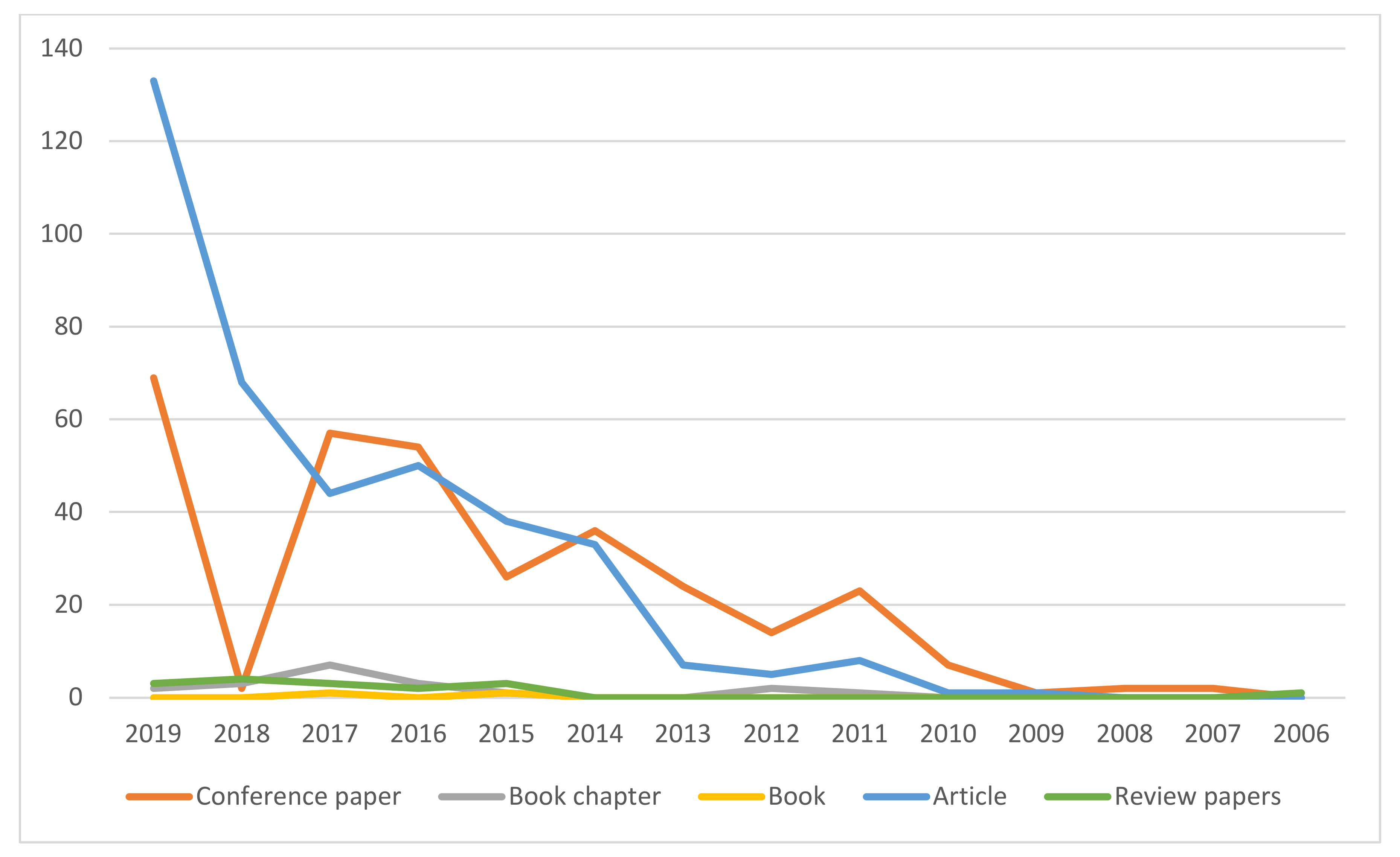
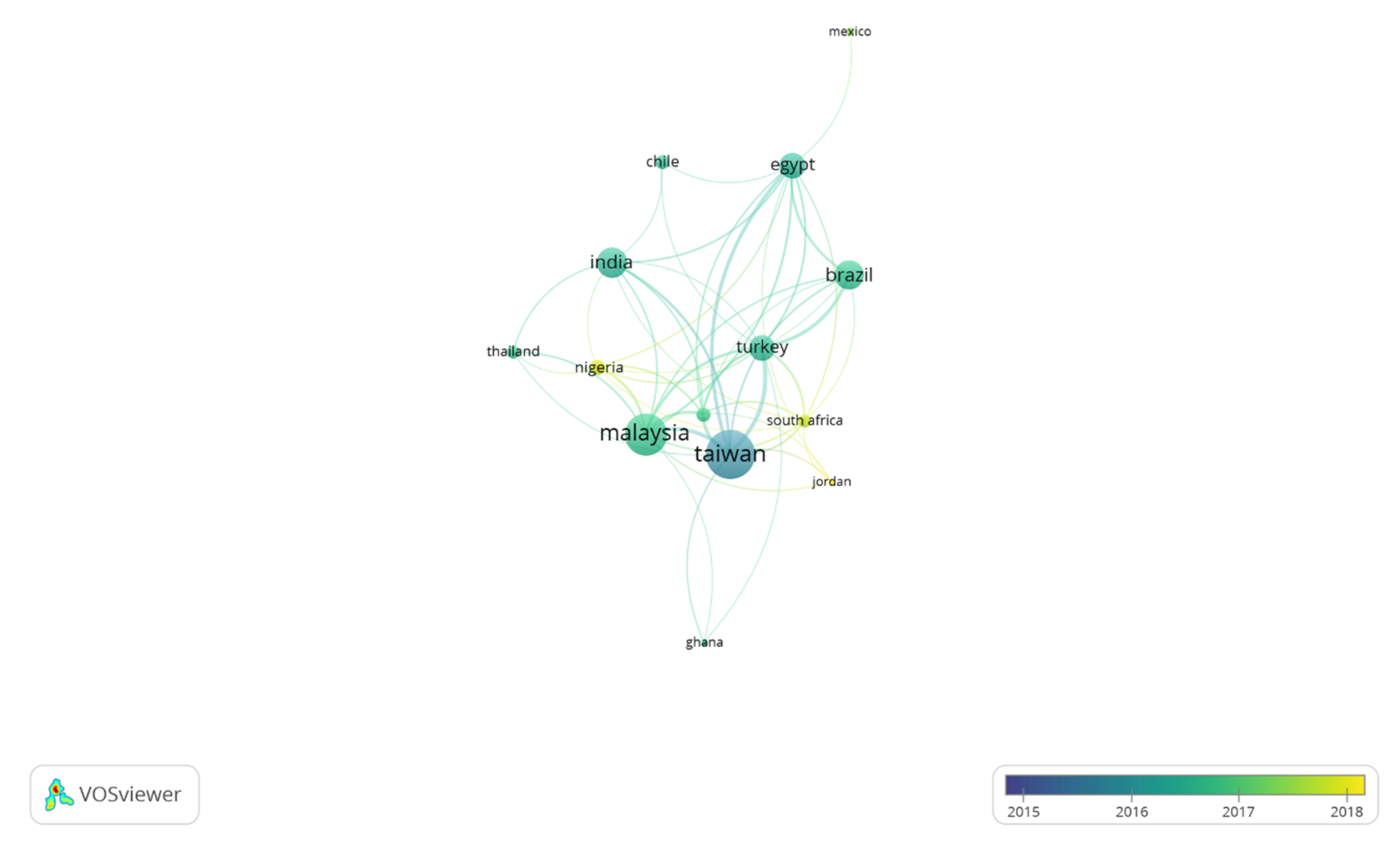
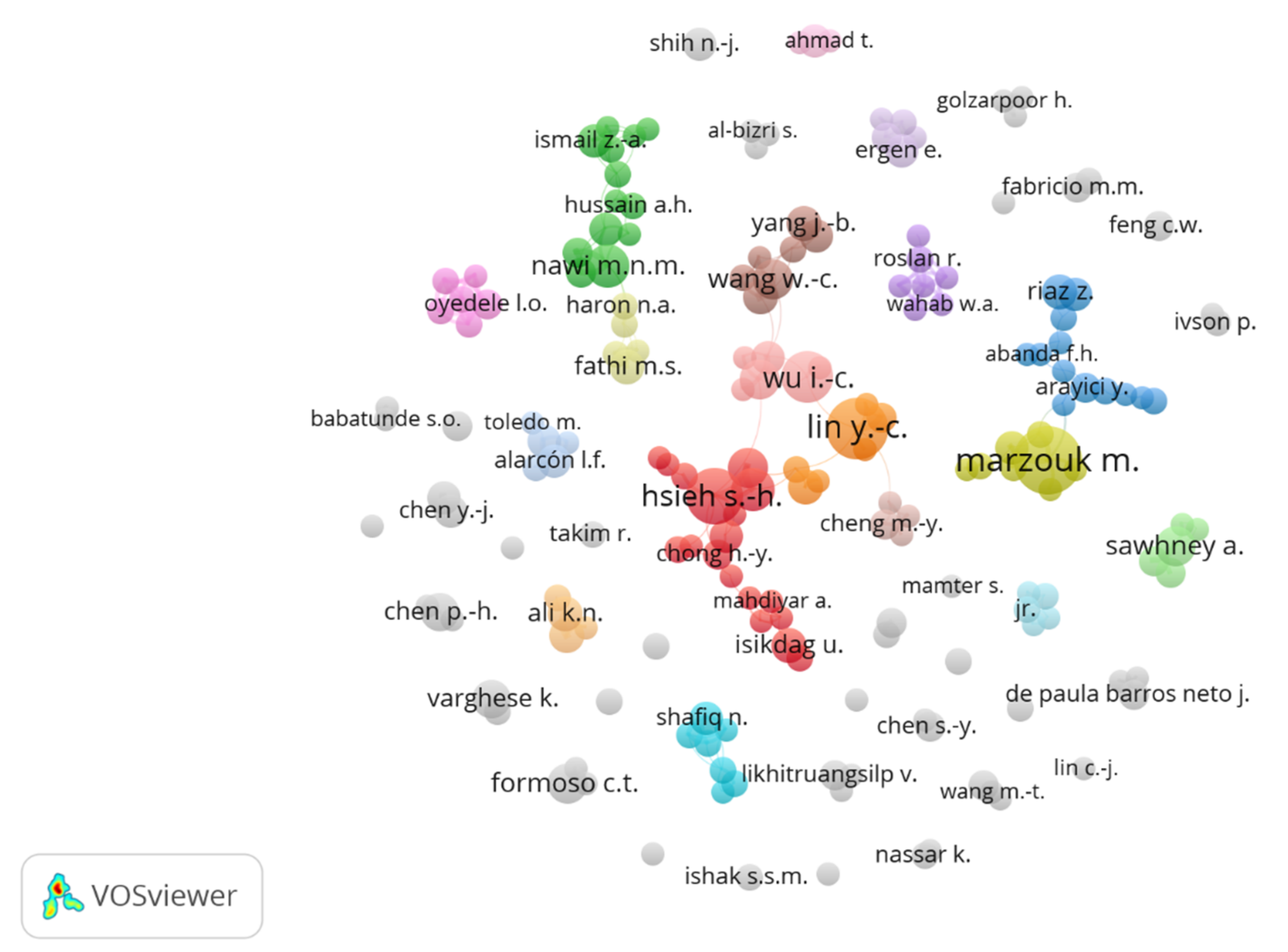
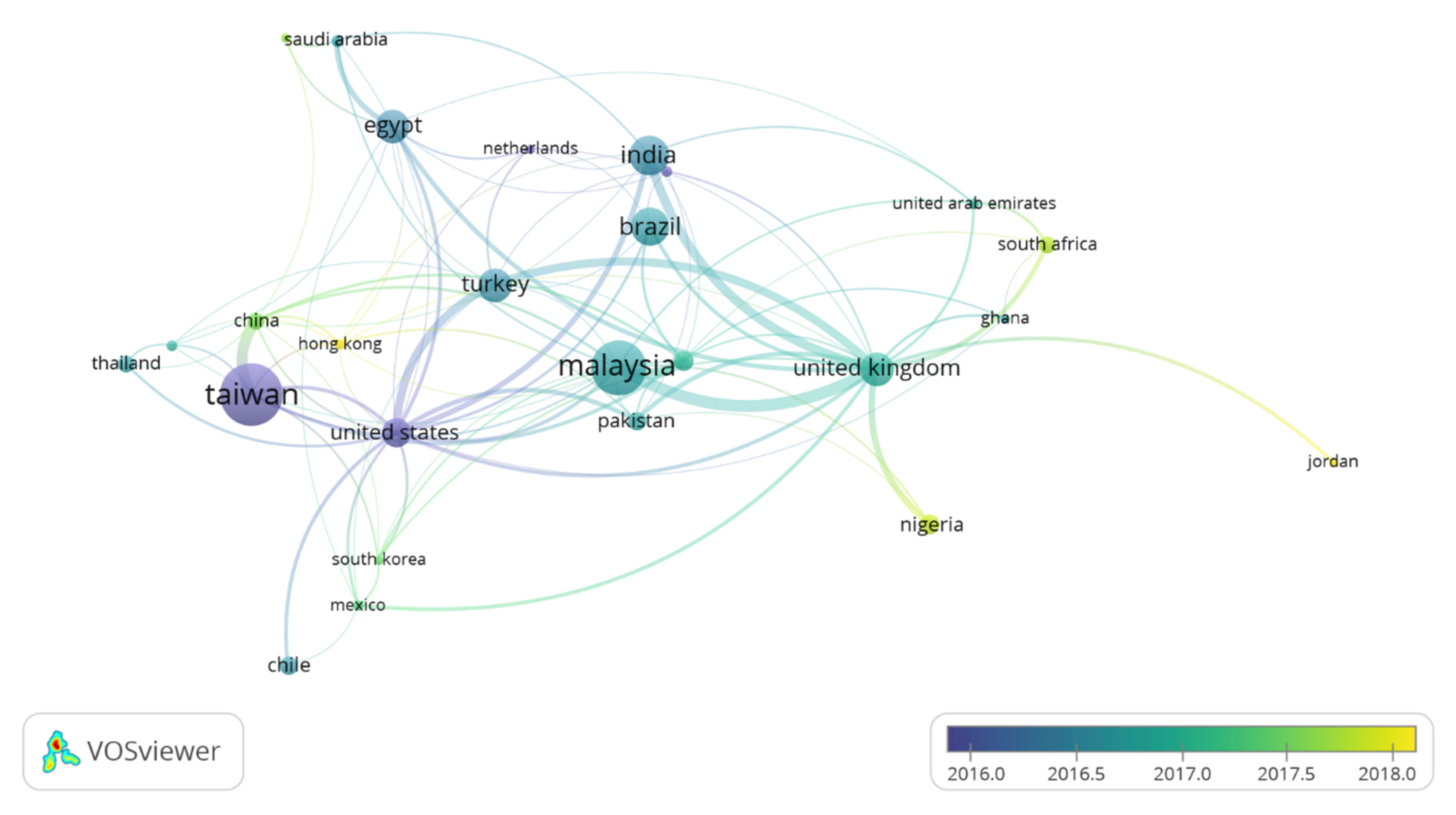
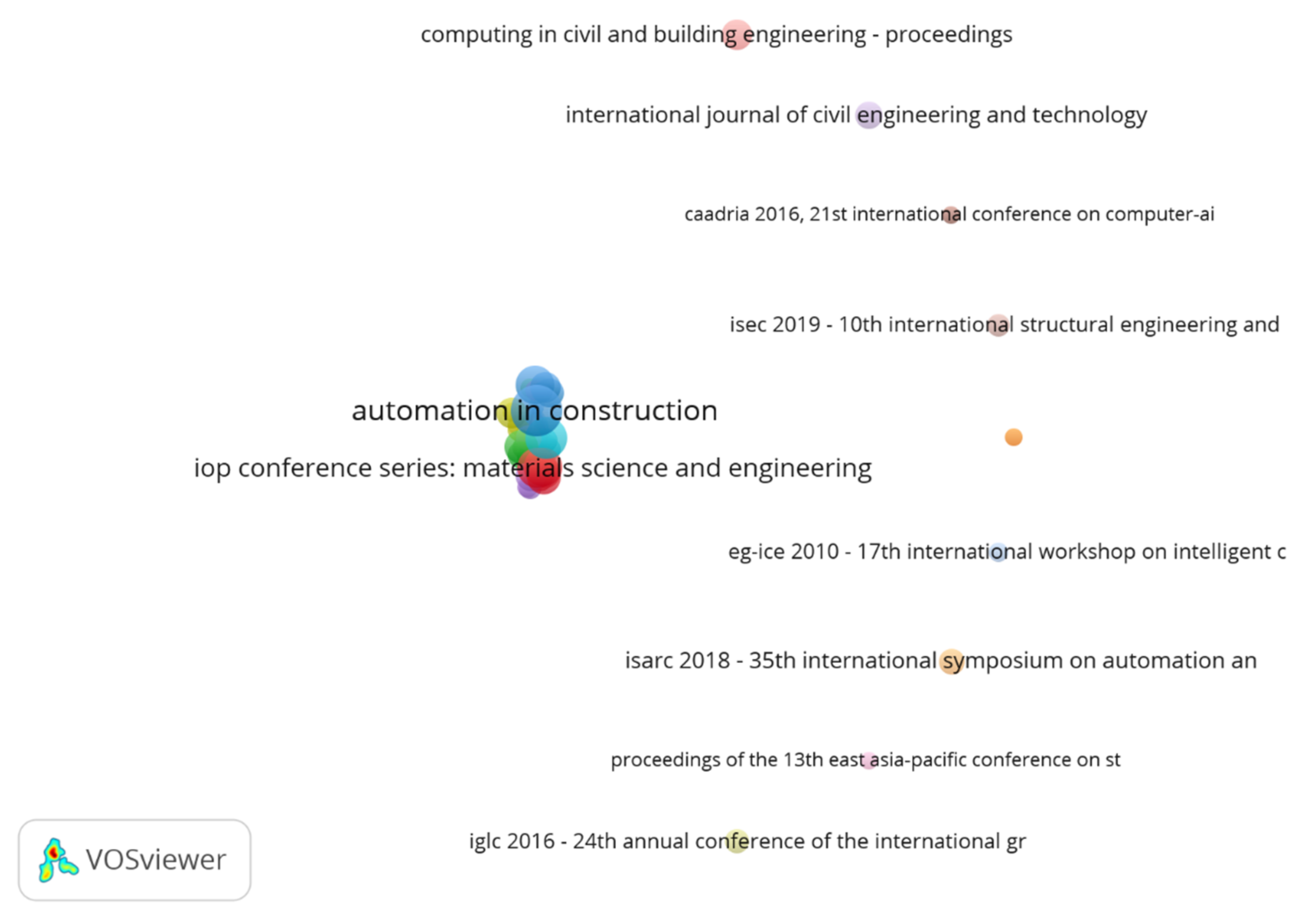


| Country | BIM Adoption Rate | Year of Assessment |
|---|---|---|
| Poland | 23% | 2015 |
| Czech Republic | 25% | 2016 |
| Japan | 46% | 2016 |
| Estonia | 51% | 2015 |
| Australia | 67% | 2016 |
| China | 67% | 2014 |
| United Kingdom | 74% | 2018 |
| Canada | 78% | 2018 |
| Denmark | 78% | 2016 |
| United States | 79% | 2015 |
| Document Title | Citation Counts |
|---|---|
| Analysis of modelling effort and impact of different levels of detail in building information models [59] | 111 |
| Adoption of Building Information Modelling technology (BIM): Perspectives from Malaysian engineering consulting services firms [35] | 69 |
| BIM for building refurbishment and maintenance: current status and research directions [60] | 68 |
| Completing the missing link in building design process: Enhancing post-occupancy evaluation method for effective feedback for building performance [61] | 67 |
| Freq | TLS | |
|---|---|---|
| Barriers | 13 | 79 |
| Internet of things (IOT) | 16 | 143 |
| Case study | 12 | 87 |
| Energy management | 6 | 50 |
| Sustainability | 17 | 126 |
| Project stakeholders | 5 | 43 |
| Laser applications | 7 | 62 |
| Laser scanner | 6 | 38 |
| Laser scanning | 6 | 55 |
| Interoperability | 22 | 233 |
| Roadmap | 5 | 36 |
| Data mining | 5 | 55 |
| Accident prevention | 46 | 71 |
| Efficiency | 16 | 141 |
| Data acquisition | 8 | 88 |
| Intelligent buildings | 14 | 169 |
| Intelligent computing | 9 | 83 |
| Software testing | 7 | 62 |
| Supply chain management | 5 | 54 |
| Material handling | 6 | 73 |
| Integrated approach | 5 | 57 |
| Interaction devices | 6 | 66 |
| Smart city | 7 | 65 |
| Structural analysis | 10 | 62 |
Publisher’s Note: MDPI stays neutral with regard to jurisdictional claims in published maps and institutional affiliations. |
© 2021 by the authors. Licensee MDPI, Basel, Switzerland. This article is an open access article distributed under the terms and conditions of the Creative Commons Attribution (CC BY) license (https://creativecommons.org/licenses/by/4.0/).
Share and Cite
Adekunle, S.A.; Ejohwomu, O.; Aigbavboa, C.O. Building Information Modelling Diffusion Research in Developing Countries: A User Meta-Model Approach. Buildings 2021, 11, 264. https://doi.org/10.3390/buildings11070264
Adekunle SA, Ejohwomu O, Aigbavboa CO. Building Information Modelling Diffusion Research in Developing Countries: A User Meta-Model Approach. Buildings. 2021; 11(7):264. https://doi.org/10.3390/buildings11070264
Chicago/Turabian StyleAdekunle, Samuel Adeniyi, Obuks Ejohwomu, and Clinton Ohis Aigbavboa. 2021. "Building Information Modelling Diffusion Research in Developing Countries: A User Meta-Model Approach" Buildings 11, no. 7: 264. https://doi.org/10.3390/buildings11070264
APA StyleAdekunle, S. A., Ejohwomu, O., & Aigbavboa, C. O. (2021). Building Information Modelling Diffusion Research in Developing Countries: A User Meta-Model Approach. Buildings, 11(7), 264. https://doi.org/10.3390/buildings11070264








